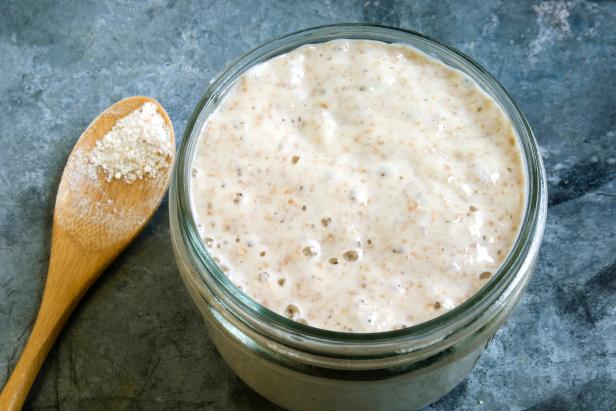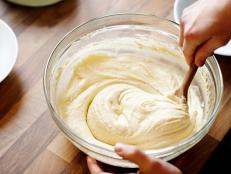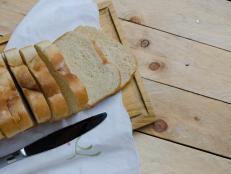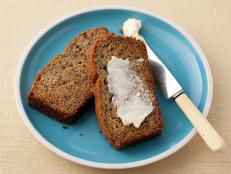What to Do with Your Sourdough Discard
Don't ditch the discard: It could be the key to some pretty great baked goods.

modesigns58 / Getty Images
Get a Premium Subscription to the Food Network Kitchen App
Download Food Network Kitchen to sign up and get access to live and on-demand cooking classes, in-app grocery ordering, meal planning, an organized place to save all your recipes and much more.
If you are making sourdough, then you have undoubtedly experienced the unfortunately named sourdough discard. Also called unfed starter, it’s the portion of your hungry starter that you remove before you feed it again, in order to prevent exponentially expanding dough that overtakes your kitchen.
Calling it “discard” can make people think it should be thrown away. But that discard is made from fermented flour and water. While it may be exhausted of leavening power, there is no reason to throw it away. Since it’s exactly what you would otherwise be feeding to make your next batch of bread, you can use it in other ways. Besides, fermented anything is thought to benefit your gut. It’s also easier to digest and has that trademark tangy flavor. With a few tips and a little experimentation, you can put it to good use. You will be on your way to reducing waste and creating tasty new dishes along with it.
First things first: If you are generating a lot of discard because you are feeding your sourdough daily: Stop! The best way to reduce feedings is by keeping your starter in the refrigerator: Colder temperatures slow down the fermentation process, so by storing in the fridge you can feed it once a week. The longer, slower fermentation also allows more sour-tasting bacteria to take over, which will amp up the flavor of whatever you put it in. If you feel like your starter has become a little sluggish, pull it out a day or two before you use it, give it a couple regular feedings, and it will be back in tip-top shape again. (Side note: Starters are generally more resilient then you think they are. Not that you should try this, but I once had a starter sit in my refrigerator for 2 months unfed, and with 2 regular feedings within 24 hours, it was back in shape again!)
You don’t need to keep a lot of starter. Less starter means less discard. Many bread recipes actually call for small amounts of starter. If you need more than you have, you can always pull it out the day before, double the amount you feed it and simply not take any out.
Now that you know what your discard really is, you can play with all sorts of quick uses for it: Pour it into a hot-cast iron skillet with some oil, top it and fry it into savory pancakes. Use it as a batter for deep-fried foods. Or blend with some more flour and butter, sprinkle with salt and herbs, spread it on a baking sheet and bake it into crackers. You can even spread it on a silicone baking mat, dry it out slowly, grind it to fine consistency, and use it as “bench flour” to dust your cutting boards and bowls with. If you keep a thicker starter or feed it before it’s completely exhausted, fry it on one side, bake in the oven until cooked through, then top with sauce and cheese and finish like pizza.
You can use it in your baking recipes by substituting it for a portion of the flour and liquid. It works well in waffles, pancakes, muffins and cakes. How? Let’s assume your starter discard is an equal amount of flour and water, since that is what most of them are. The idea is to then take out what you add in. With a scale, this is easy: You weigh your starter, divide in half to get the amounts of flour and water, then subtract those amounts from the flour and water in the recipe. But baking in cups is a little more complicated. Since water is heavier than flour, 1/4 cup water weighs about the same as a scant 1/2 cup flour. To make it more confusing, when you stir those two together they become about a heaping 1/4 cup when the flour absorbs the water. If that makes your head spin, you are not alone. To make it easy, simply calculate that 1/2 cup starter equals 1/4 cup water and 1/4 cup flour.
To bake using your discard, start by decreasing the amount of flour in the recipe. For instance, if a cake recipe calls for 2 cups flour, try 1 3/4 cups flour and 1/2 cup of starter discard. Then take the liquid in the recipe down by 1/4 cup. Whisk the starter discard directly into the liquid until it breaks apart and mix that into the dry ingredients as the recipe says. If there isn’t much liquid to stir the starter discard into, you can also alternate it with the wet and dry ingredients while mixing the batter together. Mixing it in at the end can work for pancakes, especially if you rest the batter before cooking, but not as well with cakes where you could end up overmixing.
If your cake turns out a little gummy, the problem is that you haven’t taken enough liquid out. If it’s a little dry, you took out too much. If you are replacing a liquid like milk, keep in mind you aren’t replacing the fat and sugars that are in the milk, which could affect the final texture and flavor, but depending on the recipe it might not be noticeable.
If the result is too bubbly, your starter might be less hungry, and you can try reducing the leavening. If you are replacing a lot of milk you can try adding a touch more butter or oil.
No two sourdough starters are exactly alike. People feed their starters different ratios of flour and water, use different flours, and feed on different schedules, which can all affect how quickly the starter exhausts. All of these factors impact your finished product. Don’t let this stop you from experimenting, though — just manage your expectations and make adjustments. While it’s a great idea to play with your favorite blueberry muffin recipe, you might not want to experiment for the first time on your daughter’s sweet 16 birthday cake.
And even though there are uses that don’t take much planning, there will be days you just don’t have the time to cook with your discard. In that case, you can save it in a container in the refrigerator. Keep adding to it until you have the amount you need, or until you are ready to use it. Just be sure to label it, so you don’t mix it up with your actual starter or your bread could be a flop. Literally.
Related Links:



































